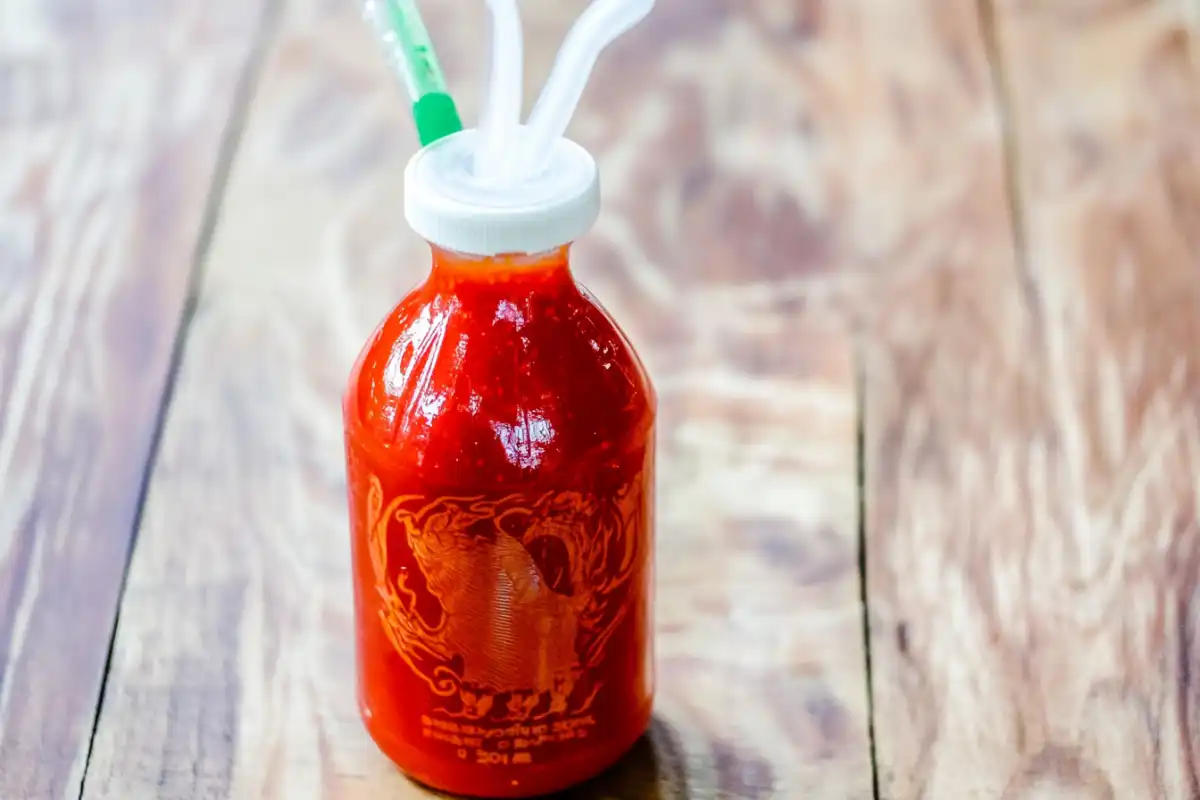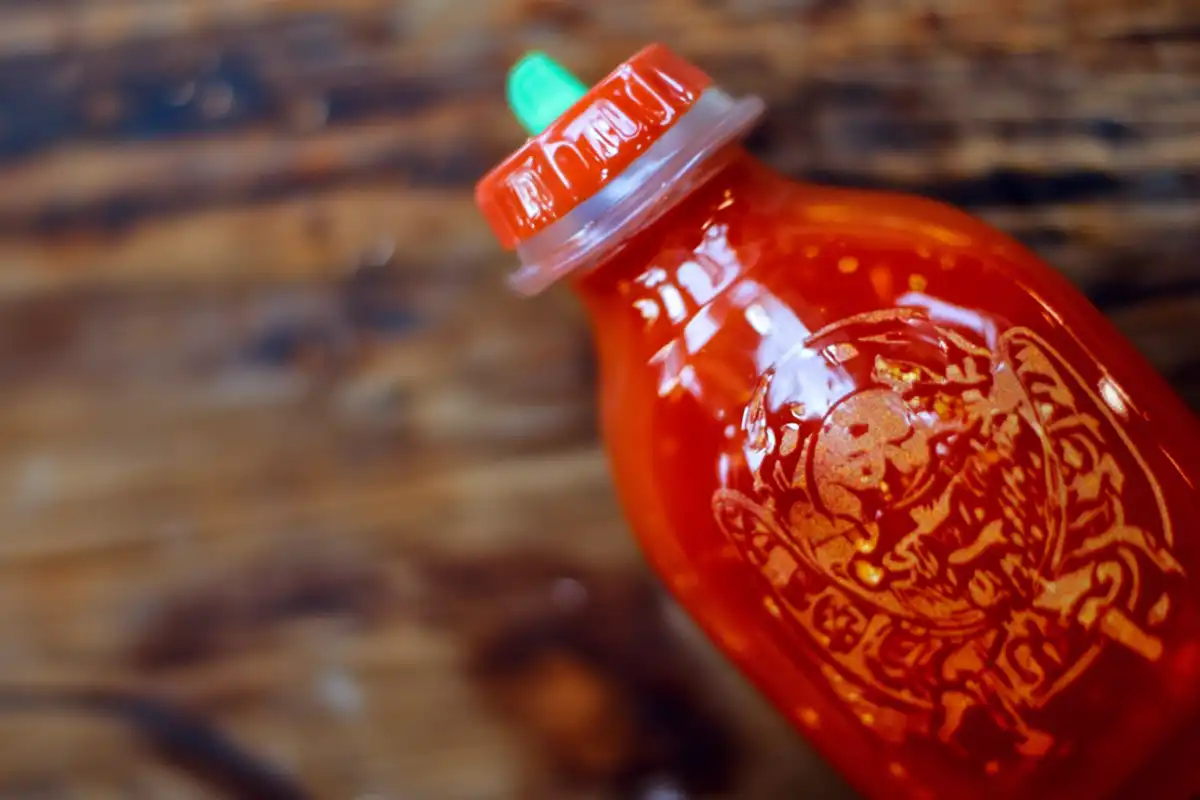Sriracha is one of the most iconic condiments in the world, known for its distinct combination of heat and tang. Whether you’re adding it to your eggs, drizzling it over noodles, or using it as a dipping sauce for your fries, Sriracha seems to go with everything. Many people wonder about its origins. Is Sriracha Chinese? Is it Korean? Or does it belong to neither of these cultures?
In this comprehensive article, we’ll explore the roots of Sriracha, its fascinating journey to global prominence, and the reasons why many people think it’s a Chinese or Korean sauce. By the end of this guide, you’ll understand where this beloved sauce comes from, how it has become a culinary staple, and how it influences fusion cuisine around the world.
What is Sriracha?
A Flavorful Hot Sauce
Sriracha is a chili-based sauce known for its bold flavors. It blends red chili peppers, distilled vinegar, garlic, sugar, and salt. These ingredients create a fiery yet tangy flavor profile, making it a favorite condiment for many. The sauce is unique because it balances spice with sweetness. The vinegar gives it a tangy undertone that keeps it from being too overwhelming.
Chefs and home cooks alike use Sriracha in various cuisines and dishes. From Asian-inspired noodles and stir-fries to Western favorites like burgers and pizza, Sriracha enhances many meals. You can even find it in cocktails, such as the Sriracha Bloody Mary.
The Heat of Red Jalapeños
The sauce’s signature heat comes from red jalapeño peppers, which are spicier than their green counterparts but milder than other chilies. This makes Sriracha accessible to a broader audience. Spice lovers enjoy the kick, while those with moderate palates appreciate its balance.
Garlic is another standout flavor in Sriracha. Unlike some hot sauces, where garlic is a background note, it plays a leading role here. It adds a savory element that complements the heat without overpowering it.
The Global Appeal of Sriracha
Though often linked with Asian cuisine, Sriracha has made its way into diverse dishes, including American breakfasts and Mexican tacos. It has become a fusion cuisine staple, blending different culinary traditions. This versatility is one of the reasons it has gained such widespread popularity.
For a look at other unique condiments crossing cultural boundaries, explore The Ultimate Guide to Tobiko: A Vibrant Sushi Ingredient. Like Sriracha, tobiko has a role in a range of dishes beyond its original culture.
The Origins of Sriracha: Thai Beginnings

From the Town of Si Racha
To uncover the true story of Sriracha, we need to travel back to Thailand. Despite its association with Chinese or Korean cuisine, its roots lie in the coastal town of Si Racha, Thailand. A Thai woman named Thanom Chakkapak created the sauce in the 1930s.
Thanom’s version of Sriracha quickly became popular in local Thai dishes, especially with seafood. It provided a perfect balance to the spicy and sour flavors common in Thai cuisine. However, it remained largely unknown outside Thailand for decades.
The Unique Thai Recipe
The name Sriracha comes directly from the town of Si Racha. The original Thai recipe used local Thai chilies, which are smaller and spicier than the jalapeños found in the American version. This gave the sauce a fiery kick, perfectly suited to Thai cooking.
In Thailand, Sriracha has a thinner consistency than its American counterpart. The Thai version also has a brighter, fresher flavor due to the use of fresher chilies and a higher concentration of vinegar. This made it the perfect complement to seafood dishes, but the sauce had yet to make its mark globally.
A Growing Regional Favorite
Over time, Sriracha became a kitchen staple throughout Thailand. However, it wasn’t until the 1980s that it gained significant attention internationally. The version that became famous outside Thailand differed slightly from the original. It gained new life in America, thanks to the efforts of David Tran.
Interested in how another Thai ingredient like Sriracha found success globally? Check out The Ultimate Guide to Tobiko. Like Sriracha, tobiko has transcended its origins to become a global sensation.
The American Sriracha Boom: Huy Fong Foods

David Tran’s Vision
The American version of Sriracha owes much of its success to David Tran, a Vietnamese immigrant with Chinese roots. After fleeing Vietnam in 1975, Tran settled in California and began producing his own version of the hot sauce he had enjoyed in Vietnam. In 1980, he founded Huy Fong Foods, named after the freighter that carried him out of Vietnam.
Tran’s vision was clear. He wanted to create a product that captured the bold, spicy flavors of the Sriracha he grew up with. But he adapted it to the tastes and ingredients available in the U.S.
Differences from the Original Recipe
Tran’s version of Sriracha differed from the original Thai recipe. Instead of using Thai chilies, Tran used red jalapeño peppers, more accessible in the U.S. This gave the sauce a milder heat, making it more appealing to American palates while retaining the spice.
He also thickened the sauce, creating a paste-like consistency rather than the thin, watery texture of the Thai version. This change made it easier to use as a condiment and allowed it to cling to food better. Additionally, Tran slightly reduced the vinegar content, creating a more balanced flavor between heat, tang, and sweetness.
Iconic Packaging and Popularity
The clear squeeze bottle with its green cap and rooster logo quickly became iconic. The design made it easy to control the amount of sauce, which appealed to both chefs and home cooks.
By the early 2000s, Sriracha had become a household name. It was used in restaurants across the U.S., from fast food joints to high-end dining. Its versatility helped drive its popularity, as it could be used in everything from tacos to scrambled eggs.
For a deeper dive into how everyday ingredients like eggs can be transformed by bold flavors, read Eggs by the Dozen: The Ultimate Guide. Like Sriracha, eggs are a versatile ingredient elevated by creative seasoning.
Is Sriracha Chinese or Korean?
The Misconception
Many people assume Sriracha is Chinese or Korean because it is frequently used in fusion dishes at Asian-American restaurants. While Sriracha plays a role in Chinese-American and Korean-American cuisine, it is neither Chinese nor Korean. As mentioned earlier, its roots are firmly Thai.
The Influence of David Tran
The confusion may also stem from David Tran’s background. Tran, who popularized Sriracha in the U.S., is of Chinese descent and came to America from Vietnam. Though he created the version of Sriracha known globally today, the sauce’s origins are purely Thai.
Sriracha’s frequent use in fusion dishes has further contributed to the misunderstanding. In Chinese and Korean restaurants, the sauce is often substituted for other chili pastes or hot sauces.
Substitutions in Fusion Cuisine
In Korean-American dishes like bibimbap, Sriracha is sometimes used instead of the traditional gochujang (a Korean chili paste). Though both add heat, Sriracha and gochujang have very different flavors. Gochujang has a deeper, umami-rich taste due to fermentation. Sriracha is fresher and more acidic.
Similarly, in Chinese-American cooking, Sriracha is often added to stir-fries or used as a dipping sauce for dumplings. Though not part of traditional Chinese cooking, it enhances the flavor of many modern Chinese-American dishes.
Fusion cuisine, where chefs blend culinary elements from different cultures, has played a significant role in Sriracha’s popularity. This blending of flavors has led to its widespread use in both Chinese-American and Korean-American dishes.
Global Popularity and Fusion Influence
From Local to Global
Sriracha has traveled far from its origins in Thailand. It is now used in kitchens worldwide. Its versatility and bold flavor have made it a favorite of both professional chefs and home cooks. In American cuisine, it has become a go-to condiment for burgers, pizza, and sandwiches. You can even find bottles of Sriracha in fast-casual restaurants and gourmet kitchens alike.
A Fusion Cuisine Favorite
In Mexican cuisine, Sriracha complements tacos, burritos, and nachos. It works well in salsas and marinades, enhancing the bold flavors of Mexican dishes.
In Italian kitchens, chefs use Sriracha as a spicy alternative to traditional tomato-based sauces. It’s drizzled over pizza or mixed into pasta dishes for an added kick. Even in Japanese fusion dishes, Sriracha has a place, where its heat balances sweeter elements like teriyaki sauce.
Sriracha’s rise to global fame mirrors the success of fusion cuisine. Chefs and home cooks continue to experiment with it, finding new ways to incorporate its distinctive flavor into different dishes.
Conclusion:
Sriracha has traveled a long way from its humble beginnings in Thailand to its current status as a global culinary icon. Originally created by Thanom Chakkapak in the town of Si Racha, the sauce has become a staple in kitchens and restaurants around the world, thanks in large part to the efforts of David Tran and Huy Fong Foods.
Through its bold flavor, versatility, and appeal to a wide range of palates, Sriracha has become a symbol of fusion cuisine. It is used in dishes from a variety of culinary traditions, including American, Mexican, Chinese, and Korean cooking. Its global popularity shows no signs of slowing down, as chefs and home cooks continue to find new ways to incorporate it into their meals.
Whether you’re using it to spice up a bowl of ramen, drizzle over tacos, or mix into a Bloody Mary, Sriracha brings a unique blend of heat and flavor that elevates any dish. Its journey from a small town in Thailand to global kitchens is a testament to the power of food to transcend cultural boundaries and bring people together through shared culinary experiences.

